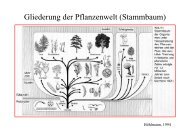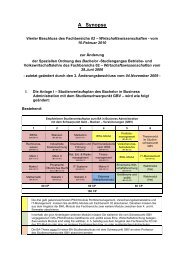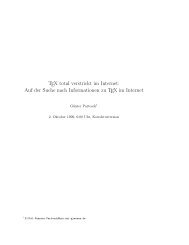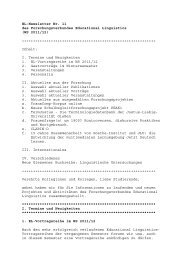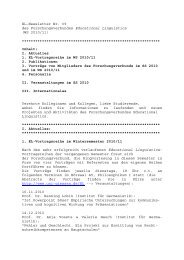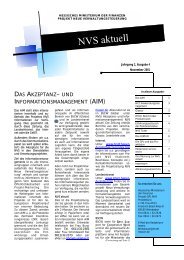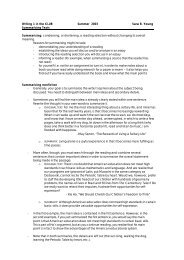Dedication. Remembering Paul Turán - Department of Mathematics
Dedication. Remembering Paul Turán - Department of Mathematics
Dedication. Remembering Paul Turán - Department of Mathematics
Create successful ePaper yourself
Turn your PDF publications into a flip-book with our unique Google optimized e-Paper software.
journal <strong>of</strong> approximation theory 86, 253 254 (1996)<br />
article no. 0066<br />
DEDICATION<br />
<strong>Remembering</strong> <strong>Paul</strong> Turan<br />
<strong>Paul</strong> Turan died 20 years ago on September 26, 1976, yet his mathematics<br />
is still as fresh as when he did it. Primarily this is because Turan<br />
frequently looked at problems from a new point <strong>of</strong> view. I have heard this<br />
expressed by those who knew his work in areas I know well as well as in<br />
areas I do not understand at all. This <strong>of</strong>ten means that it will take decades<br />
to decide on the real worth <strong>of</strong> some <strong>of</strong> his contributions, so we should not<br />
rush to judge that which we still do not completely understand.<br />
In Turan's ``Collected Papers,'' there are two interesting articles on him<br />
and his mathematics by <strong>Paul</strong> Erdos and Gabor Halasz. However, neither<br />
one comments on an important aspect <strong>of</strong> Turan's service to mathematics,<br />
namely, his editing <strong>of</strong> the selected papers <strong>of</strong> Alfred Renyi and the collected<br />
papers <strong>of</strong> Leopold Fejer. Here is a little on why this was important.<br />
Fejer was the founder <strong>of</strong> the Hungarian school <strong>of</strong> analysis. A remarkable<br />
group <strong>of</strong> analysts came through this school. George Polya wrote <strong>of</strong> Gabor<br />
Szego, ``We were both influenced, like all other young Hungarian mathematicians<br />
<strong>of</strong> that time, by Leopold Fejer.'' This was about 1910 to 1915.<br />
Twenty years later Turan was also heavily influenced by Fejer. He remarks<br />
on this in the lecture he gave at the 70th anniversary meeting <strong>of</strong> the births<br />
<strong>of</strong> Fejer and Frederick Riesz. To show the style that Turan used, after commenting<br />
that Fejer's refined techniques would <strong>of</strong>ten do in a few lines what<br />
others did in pages, he remarked that to use the same word ``calculation''<br />
for both was analogous to the use in Hungarian <strong>of</strong> the same word for the<br />
clumsy hopping <strong>of</strong> a bear and a ballerina's pirouettes.<br />
I have used the Fejer papers <strong>of</strong>ten. Turan's editing was remarkable. He<br />
commented on many <strong>of</strong> the papers, setting them into context and telling<br />
what has happened to the ideas Fejer introduced. For example, the comments<br />
on Fejer's great work on (C, 1) summability on Fourier series<br />
include references from H. Lebesgue's 1906 book to a paper on abstract<br />
ergodic theorems by W. F. Ebelein in 1949. One interesting remark which<br />
I had not known is that Fejer's name was misspelled ``Tejer'' in both the<br />
journal and in the review in Fortschritte der Mathematik.<br />
Another instance <strong>of</strong> the care that Turan took is given in his ``Das Leben<br />
von Leopold Fejer'' which starts the first volume. He quotes Hardy about<br />
this result <strong>of</strong> Fejer as follows: ``...this fundamental result has been the<br />
starting point <strong>of</strong> a mass <strong>of</strong> modern research.'' Turan's citation <strong>of</strong> this is from<br />
253<br />
0021-9045 96 18.00<br />
Copyright 1996 by Academic Press, Inc.<br />
All rights <strong>of</strong> reproduction in any form reserved.
254 DEDICATION<br />
the 1922 ``Encyclopaedia Brittanica.'' The 11th edition <strong>of</strong> the Britannica<br />
from 1910 1911 is justly famous. The 1922 edition is the 12th, which<br />
consists <strong>of</strong> 29 volumes <strong>of</strong> the 11th and 3 added volumes. The 3 new<br />
volumes are indexed separately and so have not been consulted nearly as<br />
much as the first 29 volumes. G. H. Hardy's article is in the 30th volume.<br />
There is a reference to Fejer in the index <strong>of</strong> these 3 volumes, and that<br />
Turan thought to look there shows the scholar he could be when he turned<br />
his mind to it.<br />
This scholarly side <strong>of</strong> Turan also showed itself in his knowledge <strong>of</strong> the<br />
history <strong>of</strong> mathematics. He could tell stories about the history <strong>of</strong> mathematics<br />
seemingly without end. However, much <strong>of</strong> his own mathematics was<br />
done without his having searched the literature. He had many original<br />
ideas, and they were frequently all he needed.<br />
The Fejer papers were published in 1970. Shortly thereafter, I started to<br />
look seriously at some positive sums <strong>of</strong> the classical orthogonal polynomials.<br />
I used papers <strong>of</strong> Szego and the Fejer papers as my main resources,<br />
to see what had been done and to suggest problems. Within 5 years,<br />
George Gasper had worked out a pro<strong>of</strong> <strong>of</strong> a conjecture <strong>of</strong> mine, and 10<br />
years later a special case was used by Louis de Branges as the final step in<br />
his solution <strong>of</strong> the Bieberbach conjecture. While it is probably too strong<br />
a statement to say that this work would not have been done without the<br />
ready access to Fejer's papers, the work would have been done more slowly.<br />
Another time during which Turan's editing had an impact on me was<br />
when I edited Gabor Szego's ``Collected Papers.'' I had Turan's model on<br />
which to build and used it when writing comments on Szego's papers.<br />
It is likely that similar comments will eventually be made about the papers<br />
<strong>of</strong> Renyi which Turan edited and <strong>of</strong> Turan's papers, for collected papers <strong>of</strong><br />
great mathematicians are one <strong>of</strong> the best ways <strong>of</strong> passing on original ideas.<br />
B. Meulenbeld told me a story about Turan which illustrates Turan's<br />
playfulness. They were in the same compartment <strong>of</strong> a train, but did not<br />
know each other. After some pleasant words, they discovered they were<br />
both mathematicians. After Meulenbeld introduced himself and said a little<br />
about what he did, it was Turan's turn to do the same. He took out a piece<br />
<strong>of</strong> paper and wrote P 2<br />
n (x)&P n+1(x) P n&1(x) 0, and asked Meulenbeld if<br />
he knew this. Meulenbeld said, ``Of course, that is Turan's inequality.''<br />
Turan then said ``I am Turan.''<br />
Richard Askey<br />
<strong>Department</strong> <strong>of</strong> <strong>Mathematics</strong>,<br />
University <strong>of</strong> Wisconsin,<br />
Madison, Wisconsin 53605<br />
E-mail: askey math.wisc.edu




